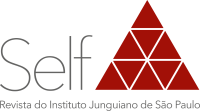Realidade física e a experiência de ser e existir
DOI:
https://doi.org/10.21901/2448-3060/self-2016.vol01.0006Palavras-chave:
física, vida, consciência, inconsciente, individuação, self, realidadeResumo
A realidade física nos é inacessível e não sabemos o que somos ou o que é a realidade. A psique – a experiência psicológica individual subjetiva, parte consciente e parte profundamente inconsciente – é a única experiência de ser e existir e a única realidade a que temos acesso. A origem da imagem de Deus está na busca de contenção para a perplexidade e o medo diante da ideia da morte e do desconhecido e da não-existência, e na busca de significado para a experiência psíquica percebida como realidade única. A diversidade de expressões das imagens de Deus – sejam declaradamente religiosas, sejam em suas formulações racionais e matemáticas – é função da cultura e assume forma narrativa psicologicamente verdadeira. Descrever a realidade experimentada é o que nos é possível e nos cabe.Downloads
Referências
Akil, H., Brenner S., Kandel E., Kendler K. S., King M. C., Scolnick E., ... Zoghbi H. Y. (2010, March 26). The future of psychiatric research: genomes and neural circuits. Science, 327(5973), 1580-1581. doi: 10.1126/science.1188654
Armstrong, K. (2000). Buddha. London: Phoenix.
Baez, J. C., & Huerta, J. (2011). The strangest numbers in string theory. Scientific American, 304(5), 60-65.
Bainbridge, W. S. (2007, July 27). The scientific research potential of virtual worlds. Science, 317(5837), 472-476. doi: 10.1126/science.1146930
Balazs, A. C., & Epstein, I. R. (2009 September 25). Emergent or just complex? Science, 325(5948), 1632-1634. doi: 10.1126/science.1178323
Balter, M. (2009, February 06). On the origin of art and symbolism. Science, 323(5915), 709-711. doi: 10.1126/science.323.5915.709
Bancroft, A. (1997). The Dhammapada. Rockport: Element.
Bekenstein, J. D. (2003). Information in the holographic universe. Scientific American, 289(2), 58-67.
Benton, M. J. (2009). The red queen and the court jester: species diversity and the role of biotic and abiotic factors through time. Science, 323(5915), 728-732. doi: 10.1126/science.1157719
Beyer, T., Townsend, D. W., Brun, T., Kinahan, P. E., Charron, M., Roddy, R., ... Nutt, R. (2000). A combined PET/CT scanner for clinical oncology. The Journal of Nuclear Medicine, 41(8), 1369-1379.
Bojowald, M. (2008). Follow the bouncing universe. Scientific American, 229(4), 44-51.
Bowler, P. J. (2009 January 09). Darwin’s originality. Science, 323(5911), 223-226. doi: 10.1126/science.1160332
Budge, E. A. W. (1996). The Book of the Dead. New York: Gramercy Books.
Clifton, T., & Pereira, P. G. (2009). Does dark energy really exist? Scientific American, 300(4), 48-55.
Colman, W. (2009). Theory as metaphor: clinical knowledge and its communication. Journal of Analytical Psychology, 54(2), 199-215. doi: 10.1111/j.1468-5922.2009.01770.x
Couzin, J. (2005, July 01). How much can human life span be extended? Science, 309(5731), 83. doi: 10.1126/science.309.5731.83
Dawkins, R. (2004). The ancestor’s tale: The dawn of evolution. Boston: Houghton Mifflin Company.
Ehrenfreund, P., Irvine, W., Becker, L., Blank, Brucato, J. R., Colangeli, L., ... International Space Science Institute ISSI-Team. (2002). Astrophysical and astrochemical insights into the origin of life. Reports on Progress in Physics, 65, 1427-1487. Retrieved from https://www.researchgate.net/profile/J_Brucato/publication/231078506_Astrophysical_and_astrochemical_insights_into_the_origin_of_life/links/0deec51dedcfeca120000000.pdf
Ellis, G. F. R. (2011). Does the multiverse really exist? Scientific American, 305(2), 38-43.
Feng, J., & Trodden, M. (2010). Dark worlds. Scientific American, 303(5), 38-47.
Gardner, J., & Maier, J. (1985). Gilgamesh, translated from the Sîn-Leqi-Unninni version. New York: Vintage Books.
Goldman, M. (2009, August 14). Epigenetic determinism. Science, 325(5942), 816. doi: 10.1126/science.1175293
Han, J., Kushner S. A., Yiu A. P., Hsiang H. L., Buch T., Waisman A., ... Josselyn S. A. (2009). Selective erasure of a fear memory. Science, 323(5920), 1492-1496. doi: 10.1126/science.1164139.
Hawking, S., & Mlodinow, L. (2010). The grand design. New York: Bantan Books.
Hood, B. (2013). Recriando a realidade. Scientific American Mente Cérebro, 241, 48-51.
Jung, C. G. (1973). Psychology of religion: West and East. In C. G. Jung, The Collected Words (Vol. 11) [Kindle]. New Jersey: Princeton University Press. Retrieved from Amazon.com
Jung, C. G. (1976a). Symbols of transformation. In C. G. Jung, The Collected Words (Vol. 5) [Kindle]. New Jersey: Princeton University Press. Retrieved from Amazon.com
Jung, C. G. (1976b). The symbolic life. In C. G. Jung, The Collected Words (Vol. 18) [Kindle]. New Jersey: Princeton University Press. Retrieved from Amazon.com
Jung, C. G. (1979). Aion: Researches into the phenomenology of the Self. In C. G. Jung, The Collected Words (Vol. 9/2) [Kindle]. New Jersey: Princeton University Press. Retrieved from Amazon.com
Jung, C. G. (1980). Archetypes and the collective unconscious. In C. G. Jung, The Collected Words (Vol. 9/1) [Kindle]. New Jersey: Princeton University Press. Retrieved from Amazon.com
Jung, C. G. (1985a). Practice of psychotherapy. In C. G. Jung, The Collected Words (Vol. 16) [Kindle]. New Jersey: Princeton University Press. Retrieved from Amazon.com
Jung, C. G. (1985b). Freud and psychoanalysis. In C. G. Jung, The Collected Words (Vol. 4) [Kindle]. New Jersey: Princeton University Press. Retrieved from Amazon.com
Jung, C. G. (1986). Símbolos da Transformação. In C. G. Jung, Obras Completas (Vol. V). Petrópolis: Ed. Vozes.
Kant, I. (1785/2013). Fundamental principles of the metaphysic of morals [Kindle]. Retrieved from Amazon.com
Lívio, M. (2011). Why math works. Scientific American, 305(2), 80-83.
Lovelock, J. (1995): Gaia: A new look at life on Earth [Kindle]. Retrieved from Amazon.com
Lwoff, A. (1954). The life cycle of a virus. Scientific American, 190(3), 34-37.
Margulis, L., & Sagan, D. (2002). O que é vida? Rio de Janeiro: Jorge Zahar.
Margulis, L. (2013). The symbiotic planet: a new look at evolution [Kindle]. Retrieved from Amazon.com
Maturana, H. R., & Varela, F. J. (1987). The tree of knowledge. Boston: Shambhala Publications.
Miller, G. (2005, July 01). What is the biological basis of consciousness? Science, 309(5731), 79. doi: 10.1126/science.309.5731.79
Moreira, M. A. (2009, Abril). O modelo padrão da física de partículas [online]. Revista Brasileira de Ensino de Física, 31(1), 1306-1311. Retrieved from http://www.scielo.br/scielo.php?script=sci_arttext&pid=S1806-11172009000100006&lng=en&nrm=iso&tlng=pt
Musser, G. (2010). Could time end? Scientific American, 303(3), 84-91.
Nicolelis, M. A. L. (2011). Mind out of body. Scientific American, 304(2), 80-83.
Novello, M. (2012). O bóson de Higgs e a massa de todos os corpos. Scientific American Brasil, 124, 42-49.
Orgel, L. E. (2004). Prebiotic chemistry and the origin of the RNA world. Critical Reviews in Biochemistry and Molecular Biology [online], 39(2), 99-123. doi: 10.1080/10409230490460765. Retrieved from http://bonhamchemistry.com/wp-content/uploads/2012/01/RNA_World.pdf
Pennisi, E. (2005, July 01). Why do humans have so few genes? Science, 309(5731), 80. doi: 10.1126/science.309.5731.80
Pennisi, E. (2009, November 06). No genome left behind. Science, 326(5954), 794-795. doi: 10.1126/science.326_794
Pennisi, E. (2010, May 21). Genomics. Synthetic genome brings new life to bacterium. Science, 328(5981), 958-959. doi: 10.1126/science.328.5981.958
Prusiner, S. B. (1984). Prions. Scientific American, 251(4), 50-59.
Pigliucci, M. (2009, February 06). The overwhelming evidence. Science, 323(5915), 716-717. doi: 10.1126/science.1168718
Reale, G., & Antiseri, D. (2003). Filosofia pagã antiga. In História da filosofia (Vol. 1). São Paulo: Paulus.
Riess, A. G., & Turner, M. S. (2004). From slowdown to speedup. Scientific American, 290(2), 62-67.
Riordan, M., Tonelli, G. & Wu S. L. (2013, May 21). The Higgs at last. Scientific American, 307(4), 66-73.
Schmidt, K. (2000). Göbekli Tepe, Southeastern Turkey: a preliminary report on the 1995-1999 excavations. Paléorient [online], 26(1), 45-54. Retrieved from http://www.persee.fr/doc/paleo_0153-9345_2000_num_26_1_4697
Seife, C. (2005, July 01). Can the laws of physics be unified? Science, 309(5731):82. doi: 10.1126/science.309.5731.82
Smolin, L. (2004). Atoms of space and time. Scientific American, 290(1), 66-75.
Steiner, J. E. (2006). A origem do universo. Estudos Avançados [online], 20(58),231-248. Retrieved from http://www.scielo.br/scielo.php?pid=s0103-40142006000300022&script=sci_arttext
Tinôco, C. A. (1996). As Upanishads. São Paulo: IBRASA.
Tomasello, M. (2000). Primate cognition: Introduction to the issue. Cognitive Science, 24(3), 351-361. Retrieved from http://onlinelibrary.wiley.com/store/10.1207/s15516709cog2403_1/asset/s15516709cog2403_1.pdf;jsessionid=344ED0CDA2E6EEB55C9AF43CFD9185AD.f01t04?v=1&t=imf476xf&s=945b2f0f2eaf745d5064d9a3733238c29cce77a7
Turner, M. S. (2009). Origin of the universe. Scientific American. 301(3), 36-43.
Veneziano, G. (2012). The myth of the beginning of time. Scientific American, 290(5), 54-65.
Vernadsky, V. I. (1998). The biosphere [Kindle]. New York: Copernicus/Spring-Verlag. Retrieved from Amazon.com
von Franz, M. (2003). Mitos de criação. São Paulo: Paulus.
Wilkins, C. (1785). The Bhagavad Gita, in the Public Domain [Kindle]. Retrieved from Amazon.com
Zilhão, J., Angelucci, D. E., Badal-García, E., d'Errico F., Daniel, F., Dayet L., ... Zapata, J. (2010). Symbolic use of marine shells and mineral pigments by Iberian Neanderthals. Proceedings of the National Academy os Sciences of the United States of America, 107(3), 1023-1028. doi: 10.1073/pnas.0914088107. Retrieved from http://www.pnas.org/content/107/3/1023.full
Zimmer, C. (2009, January 09). On the origin of life. Science, 323(5911):198-199. doi: 10.1126/science.323.5911.198
Zoja, L. (2005). Carl G. Jung como fenômeno histórico-cultural. Cadernos Junguianos, 1, 18-31.
Downloads
Arquivos adicionais
Publicado
Como Citar
Edição
Seção
Licença
A Self adota a licença Creative Commons “Atribuição 4.0 Internacional”, classificada como Licença de Cultura Livre, que permite a cópia e distribuição dos trabalhos publicados em qualquer meio ou formato e permite que outros transformem, façam adaptações ou criem obras derivadas para todos os usos, mesmo comercial, desde que seja dado o devido crédito à publicação. Mais detalhes em http://creativecommons.org/licenses/by/4.0/.
Ao submeterem trabalhos para a revista, os autores aceitam os termos desta licença e concordam em ceder os direitos autorais do manuscrito para a publicação. Junto com o trabalho, os autores devem enviar o documento de transferência de direitos autorais devidamente assinado.










